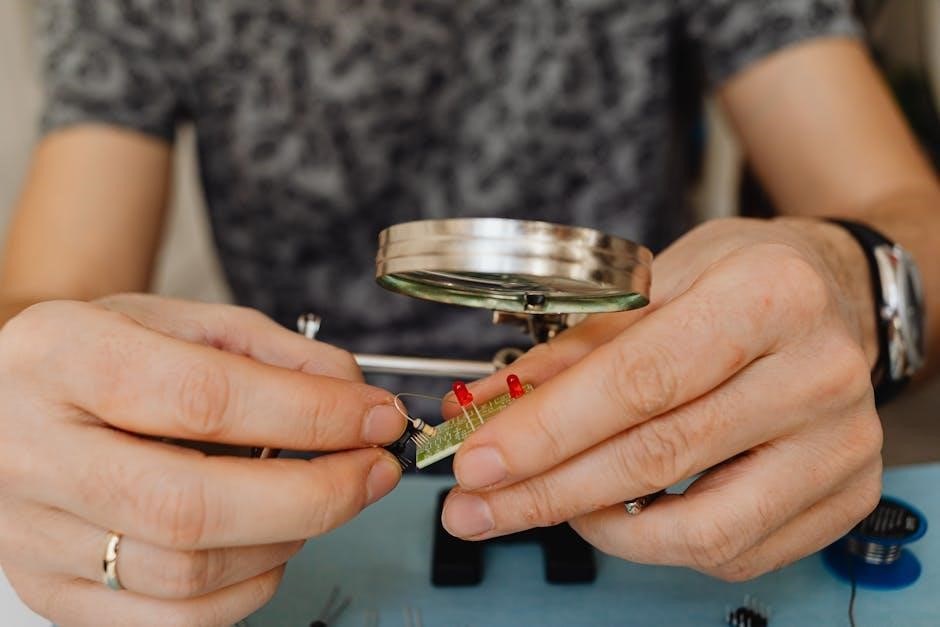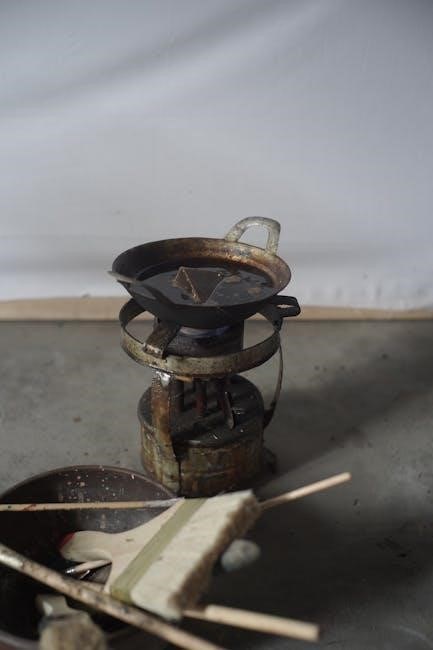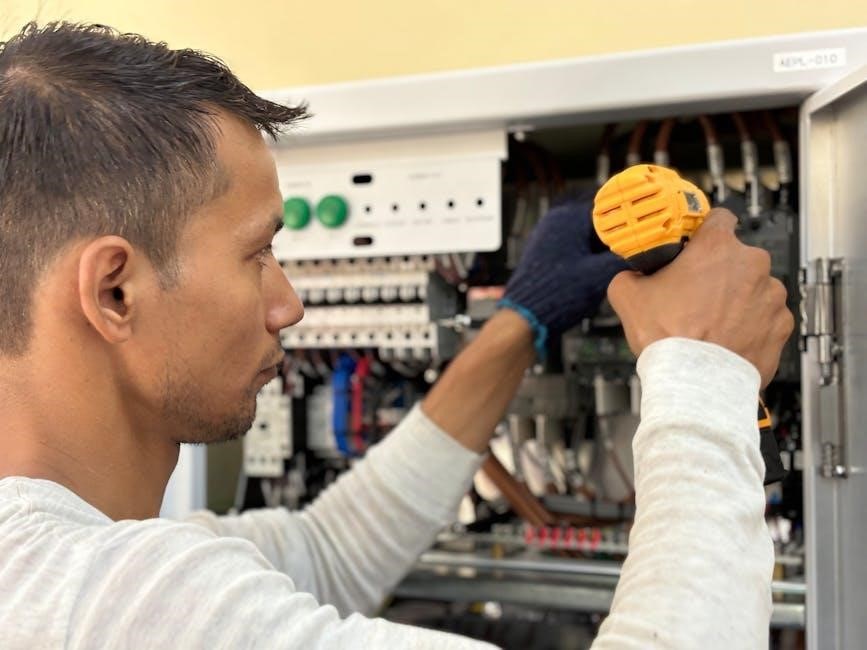This guide provides essential steps for diagnosing and resolving common issues with Beckett burners, ensuring reliable operation and optimal performance in your heating system.
Overview of Beckett Burners and Their Importance
Beckett burners are critical components in heating systems, ensuring efficient combustion of fuel for boilers and furnaces. They are widely used in residential and commercial applications due to their reliability and performance. Beckett burners are designed to provide consistent heat output while maintaining safety standards. Their advanced technology, such as the GeniSys control system, allows for precise monitoring and adjustment of combustion processes. Proper installation, maintenance, and troubleshooting of Beckett burners are essential to ensure optimal functionality and longevity. These burners play a vital role in keeping heating systems running smoothly and efficiently.
Essential Safety Precautions for Troubleshooting
Always disconnect power and fuel supply before starting any troubleshooting to prevent accidents. Wear protective gear, including gloves and safety glasses. Ensure the area is well-ventilated to avoid inhalation of harmful fumes. Never attempt repairs near open flames or sparks. Follow the manufacturer’s guidelines and safety protocols strictly. If unsure about a procedure, consult a professional. Failure to adhere to safety precautions can lead to severe injury, fire hazards, or property damage. Prioritize safety to ensure a secure troubleshooting process for Beckett burners.

Common Issues with Beckett Burners

Common issues with Beckett burners include ignition failure, frequent reset button tripping, and inconsistent flame patterns, all of which can disrupt heating system performance significantly.
The Burner is Not Igniting
If the burner fails to ignite, it could indicate issues with the ignition transformer, electrodes, or fuel supply. A weak ignition transformer may not produce enough voltage, while misaligned or cracked electrodes can prevent proper spark formation. Additionally, a lean fuel mixture or a faulty cad cell can disrupt the ignition process. To resolve this, check the transformer’s output, ensure electrodes are clean and correctly positioned, and verify the fuel flow. If the cad cell is not detecting the flame, it may need replacement. Always refer to the manual for specific instructions and safety precautions to avoid further complications.
The Reset Button is Tripping Frequently
Frequent tripping of the reset button indicates a potential issue with the burner’s safety mechanisms. This could be due to low voltage, a faulty primary control, or blockages in the burner housing. Check for proper electrical connections and ensure the voltage supply meets specifications. Inspect the burner nozzle and housing for debris or obstructions, as these can trigger the safety shutdown. Additionally, verify that the fuel flow is adequate and unobstructed. If the problem persists, consult the troubleshooting section of the manual or contact a certified technician to avoid further complications and ensure safe operation of the burner system.

Low Firing Rate or Inconsistent Flame
A low firing rate or inconsistent flame can result from improper air-fuel mixture settings, clogged nozzles, or worn-out components. Check the nozzle for debris and clean or replace it if necessary. Inspect the fuel line for blockages or leaks, ensuring proper flow. Adjust the air shutter to achieve the correct combustion balance, as outlined in the manual. Additionally, verify the ignition system’s integrity and ensure electrodes are correctly aligned. If the issue persists, consult the troubleshooting guide or contact a professional to restore optimal burner performance and efficiency.

Checking the Fuel Supply and Power
Ensure the fuel tank is not empty and the supply line is clear. Verify electrical connections are secure and power is reaching the burner system properly.

Ensuring Proper Fuel Flow
To ensure proper fuel flow in your Beckett burner, start by checking the nozzle for clogs or debris, which can restrict oil flow. Clean or replace the nozzle if necessary. Next, verify that the oil tank is not empty, as a low fuel level can disrupt operation. Check the fuel filter and replace it if dirty or clogged. Inspect the fuel line for kinks, blockages, or leaks, and ensure all connections are secure. If issues persist, consider bleeding the fuel line to remove air pockets. Proper fuel flow is critical for consistent burner performance and preventing shutdowns.
Verifying Electrical Connections
Verifying electrical connections is crucial for the proper functioning of your Beckett burner. Start by ensuring the burner is powered off before inspecting any components. Check all wiring for signs of wear, damage, or loose connections. Verify that the circuit breaker or fuse controlling the burner is intact and has not tripped or blown. Use a multimeter to test for voltage at the burner terminals, ensuring it matches the specifications in the manual. Secure any loose connections and replace damaged wires to prevent malfunctions. Proper electrical connections are essential for safe and reliable burner operation.

Cleaning and Maintenance Tips
Regular cleaning of the nozzle, electrodes, and burner housing is essential for optimal performance. Inspect and replace worn parts to ensure reliability and efficiency in operation.
Cleaning the Nozzle and Electrodes
Cleaning the nozzle and electrodes is crucial for maintaining proper burner function. Start by shutting off the power and allowing the burner to cool. Remove the nozzle and soak it in a solvent to dissolve any residue. Use a wire brush to gently scrub away debris and ensure the nozzle’s holes are clear. For the electrodes, check their alignment and cleanliness. Use a soft cloth or fine-grit sandpaper to remove corrosion or soot. Properly realign and secure the electrodes before restarting the burner. Regular cleaning prevents clogs and ensures consistent ignition and flame quality.
Inspecting and Replacing Worn Parts
Regular inspection of burner components is vital for optimal performance. Check the coupling for wear or misalignment, ensuring it’s securely attached to the motor and burner housing. Inspect the blower wheel for debris or damage, cleaning or replacing it as needed. Look for signs of wear on the electrodes, such as corrosion or uneven surfaces, and replace them if necessary. Examine the nozzle for clogs or erosion, replacing it with the correct specification if damaged. Addressing worn parts promptly prevents operational issues and extends the burner’s lifespan, ensuring efficient and safe heating system operation.

Advanced Troubleshooting Techniques
Utilize the GeniSys control system for detailed diagnostics and real-time monitoring of burner performance. Adjust air-fuel mixtures precisely to optimize combustion efficiency and address complex operational issues effectively.
Using the GeniSys Control for Diagnostics
The GeniSys control system offers advanced diagnostic capabilities for Beckett burners, providing real-time monitoring of operational performance. By accessing the control panel, technicians can identify error codes and analyze data to pinpoint issues quickly. This system simplifies troubleshooting by displaying detailed information about fuel flow, ignition status, and safety device functionality. Regular use of the GeniSys control ensures proactive maintenance, reducing downtime and optimizing burner efficiency. Its intuitive interface makes it easier to address complex problems, ensuring your heating system runs smoothly and safely throughout the year.
Adjusting Air-Fuel Mixtures
Proper air-fuel mixture adjustment is crucial for efficient and safe operation of Beckett burners. Start by consulting the burner manual to determine the correct air tube and nozzle combination for your system. Use the adjustment screws on the air tube to modify the airflow, ensuring it aligns with the recommended specifications. Periodically inspect and clean the air intake to prevent blockages that could disrupt the mixture. An optimal air-fuel ratio enhances combustion efficiency, reduces emissions, and prevents issues like sooting or incomplete burning. Always refer to the manufacturer’s guidelines for precise adjustments tailored to your burner model.
For further assistance, visit Beckett’s official website for manuals, troubleshooting guides, and contact information. Reach their support at (866) 645-2873 for expert help and resources.
Final Tips for Effective Troubleshooting

Always start by checking the fuel supply and ensuring proper power to the burner. Refer to the Beckett manual for specific instructions and safety guidelines. Clean or replace clogged nozzles and dirty electrodes to restore proper ignition. Adjust the air-fuel mixture carefully to achieve a consistent flame. If issues persist, consult the troubleshooting section of the manual or contact Beckett support. Regular maintenance, such as inspecting electrical connections and replacing worn parts, will prevent future problems. Keep a record of repairs and adjustments for reference. Remember, safety should always be your top priority when working with combustion equipment.
Where to Find Additional Support
For further assistance with Beckett burner troubleshooting, visit the official Beckett website, which offers a library of product manuals, troubleshooting guides, and technical resources. Contact Beckett’s customer service team for personalized support or to locate a regional sales manager. Additionally, register for training courses to enhance your understanding of burner maintenance and repair. Exploded views and warranty information are also available online. If issues persist, consult certified professionals or refer to the Beckett GeniSys control diagnostics for advanced solutions. Ensure all repairs align with safety guidelines and manufacturer recommendations.
